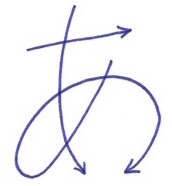In Japanese, we have three writing systems: Hiragana, Katakana, and Kanji (Chinese characters). Today’s topic is how to write Japanese letters appropriately. This is going to apply to all of the three groups of letters in Japanese. By the way, in case you are wondering why the heck we have three different sets of letters and how they function differently in Japanese, you can go to this blog where I explained the difference of Hiragana, Katakana, and Kanji. Whether you attempt to write Hiragana, Katakana, or Kanji, keep these basic rules in mind. They are crucial especially if your goal is to learn to write Japanese letters accurately and beautifully. Know that once you develop a bad habit, it is very hard to shake them off. I’ve seen such cases too many times among my students in my teaching career. So, please follow these fundamental rules as you practice writing Japanese letters. On the side note, good penmanship is highly valued in the culture. Interested in learning all the 46 Hiragana letters? I have the complete lessons on my blog, Learn to Write Hiragana. Interested in learning Japanese online? Check all the courses available HERE.
Rule 1: Stroke Direction
There are only two directions of stroke when it comes to Japanese letters:
 Left to right, OR
Left to right, OR- Top to bottom.
Traditionally, Japanese people wrote sentences vertically, not horizontally, using a writing brush, Fude. With a writing brush, it is easier to write each stroke of a letter from left to right and top to bottom. As a result, Japanese people have accustomed to writing letters that way. It, in fact, helps you write letters in a flow and beautifully. I am normally not too strict about the stroke order. However, I would highly recommend following the correct order because it helps your letters look well-balanced.
Rule 2: Three Types of Stroke Ending
Each stroke of each letter has one of the following endings: Stop (tome), Brush-up (hane) and Release (harai). Again, this has resulted from the custom of writing with a brush in old days. They are still the vital elements of all the Japanese letters. In Hiragana lessons on this website, I have indicated each ending of each letter as I introduce them. I encourage you to practice as you refer to each Hiragana lesson video. 
Rule 3: Follow Hand-written Versions
Some Hiragana letters could look quite distinctive between hand-written version and printed version. Be sure that you master the hand-written version of the letter. See the examples below. Hiragana “ri” in the printed-font looks as if it is written in one long stroke. On the other hand, the hand-written one has two strokes. The latter is the model you have to copy. Your “ri” has to be in two strokes when you write with your hand. In this technology era, you can literally find countless fonts of Hiragana letters on various devices. The most popular Hiragana font on a computer is Mincho font. Mincho font makes Hiragana look stylish, but not accurate as hand-written letters. It is totally ok to use it when you are typing Japanese to a friend, but do not model Mincho font when you practice writing Hiragana.  Within my Hiragana lessons, I use a font called Kyokasho-tai (Textbook font). It is used in textbooks in Japan to teach children how to write letters and is the closest to the hand-written version. I also have a Hiragana chart and practice sheets for you to download. Rest assured that I used Textbook font to create those materials. 🙂
Within my Hiragana lessons, I use a font called Kyokasho-tai (Textbook font). It is used in textbooks in Japan to teach children how to write letters and is the closest to the hand-written version. I also have a Hiragana chart and practice sheets for you to download. Rest assured that I used Textbook font to create those materials. 🙂 
Know How to Write Japanese Letters Correctly
I’m sorry if I made you too nervous about writing Japanese letters! That was not my intention. I at least wished to give you the information so that you have the awareness of how to write Japanese letters correctly. As I stated in the About Me section, I have been teaching Japanese for many years. Guiding students to acquire Hiragana and Katakana letters correctly is one of my focus when I teach at the college. It’s funny, but in many cases, students who mastered Japanese letters correctly ended up becoming overall successful students. They tend to understand the grammar better and improve their communication skills in Japanese. Commitment and hard work correlate to success. Learning how to write Japanese letters may feel like a daunting task, but please don’t give up. Take one letter at a time. Eventually, you will master all the Hiragana and Katakana. Go to the Hiragana Lesson section. Watch each lesson video in order and follow instructions. provide useful materials for your writing practice on this website. At the moment, I have a Hiragana chart and practice sheets for you to download. Provide the information below and I’ll send them to your way right away! If you are looking for a good Hiragana app, I recommend this one by the Japan Foundation. It is a free app that comes in English, Indonesian, and Thai versions. I will greatly help you with Hiragana memorization.
Watch the video below to learn how to use it. Happy learning! ![]() 裕子先生 (ゆうこせんせい)Yuko-sensei
裕子先生 (ゆうこせんせい)Yuko-sensei
Thank you very much for this information.
Angie-san,
どういたしまして。Doo itashimashite. (You are welcome) I hope you found the article useful. 🙂
Yuko-sensei
I can’t find anywhere why the word sensei せんせい is spelled like sensee. Is there a rule or something when the word ends in ei? I’m still learning maybe I skip something somewhere.
ケイラさん、はじめまして。
It’s Japanese long vowel (double vowel) rules. There are mismatches between spelling and pronunciation when it comes to EI and OU in spelling. Every time when you encounter the sequence of EI in spelling, you pronounce it EE. So, せんせい (se-n-se-i) is pronounced se-n-sE-E and けいかく (ke-i-ka-ku) is kE-E-ka-ku.
Same goes for the vowel OU sequence. It is pronounced OO. For instance, おとうさん is spelled o-to-u-sa-n but we pronounce it o-tO-O-sa-n. こうこう (ko-u-ko-u) is kO-O-kO-O in pronunciation.
Now, how to spell these double vowels in Romaji is not consistent because Romaji (Western alphabets) are not our letters. We Japanese spell the word “se-n-se-i” either in Hiragana せんせい or in Kanji 先生 and naturally pronounce it se-n-se-e. So, spelling it either “sensei” or “sensee” in Romaji doesn’t matter to us. Some people spell it as they would spell in Hiragana (sensei) and others spell it as they would actually pronounce it (sensee). Both cases are widely accepted so you can choose either way in Romaji.
Japanese native speakers unconsciously pronounce せんせい se-n-se-e and most people are even not aware that there is a mismatch between spelling and pronunciation. Maybe that is why you couldn’t find this information easily online. One has to have the knowledge of Japanese linguistics to be able to explain this to you. I always explain this double-vowel rules to my students in my class during the first few weeks as they shift their minds from Romaji to Hiragana. This is another reason why we Japanese teachers strongly recommend to our learners to start learning Japanese in Hiragana from an early stage, not in Romaji.
I hope this cleared your confusion. がんばってください。
Yuko-sensei
How can I learn Japnese from zero? I don’t have any background.
I have a complementary starter course designed for absolute beginners. It is free to join. You can go to smilenihongo.com/minicoursefree to sign up.
I am a begginer and still don’t get why whenever I translate something with my name in it, they write my name first before the sentence.
Enysha-san,
I don’t quite understand what you are asking. Can you give me an example sentence that you are going to translate into Japanese?
Yuko-sensei
先生、どもありがとうございます。
Elenaさん、
どういたしまして!
ありがとございます!
アンナさん
どういたしまして!